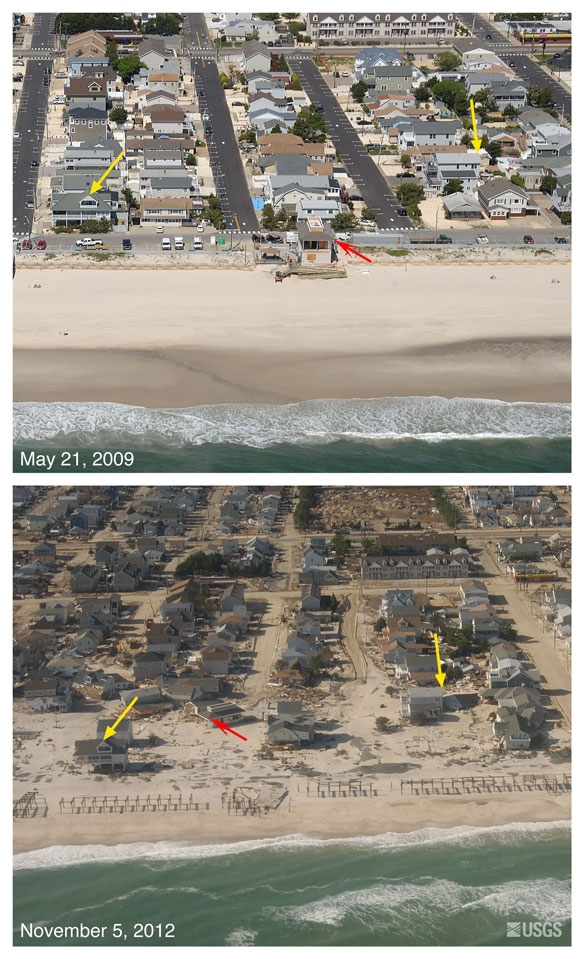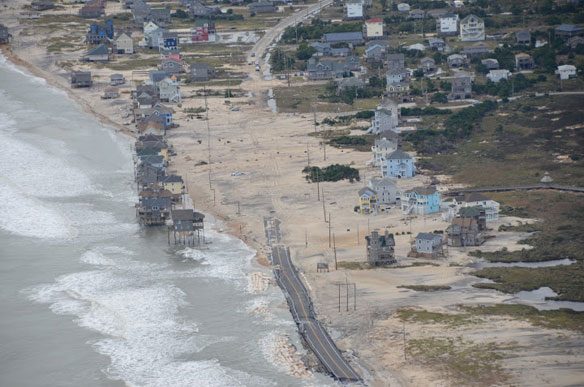
Aerial pictures of North Carolina’s coast, after superstorm Sandy devastated the area. Photo courtesy of: © Program for the Study of Developed Shorelines (PSDS) / WCU
By USGS-NOAA
According to a new technical report, the effects of climate change will continue to threaten the health and vitality of U.S. coastal communities’ social, economic and natural systems.
The report, Coastal Impacts, Adaptation, and Vulnerabilities: a technical input to the 2013 National Climate Assessment, authored by leading scientists and experts, emphasizes the need for increased coordination and planning to ensure U.S. coastal communities are resilient against the effects of climate change.
The recently released report examines and describes climate change impacts on coastal ecosystems and human economies and communities, as well as the kinds of scientific data, planning tools and resources that coastal communities and resource managers need to help them adapt to these changes.
“Sandy showed us that coastal states and communities need effective strategies, tools and resources to conserve, protect, and restore coastal habitats and economies at risk from current environmental stresses and a changing climate,” said Margaret A. Davidson of NOAA’s Office of Ocean and Coastal Resource Management and co-lead author of the report. “Easing the existing pressures on coastal environments to improve their resiliency is an essential method of coping with the adverse effects of climate change.”
A key finding in the report is that all U.S. coasts are highly vulnerable to the effects of climate change such as sea-level rise, erosion, storms and flooding, especially in the more populated low-lying parts of the U.S. coast along the Gulf of Mexico, Mid-Atlantic, northern Alaska, Hawaii, and island territories. Another finding indicated the financial risks associated with both private and public hazard insurance are expected to increase dramatically.
“An increase in the intensity of extreme weather events such as storms like Sandy and Katrina, coupled with sea-level rise and the effects of increased human development along the coasts, could affect the sustainability of many existing coastal communities and natural resources,” said Virginia Burkett of the U.S. Geological Survey and co-lead author of the report.
The authors also emphasized that storm surge flooding and sea-level rise pose significant threats to public and private infrastructure that provides energy, sewage treatment, clean water and transportation of people and goods. These factors increase threats to public health, safety, and employment in the coastal zone.
The report’s authors noted that the population of the coastal watershed counties of the U.S. and territories, including the Great Lakes, makes up more than 50 percent of the nation’s population and contributed more than $8.3 trillion to the 2011 U.S. economy but depend on healthy coastal landforms, water resources, estuaries and other natural resources to sustain them. Climate changes, combined with human development activities, reduce the ability of coasts to provide numerous benefits, including food, clean water, jobs, recreation and protection of communities against storms.
Seventy-nine federal, academic and other scientists, including the lead authors from the NOAA and USGS, authored the report which is being used as a technical input to the third National Climate Assessment — an interagency report produced for Congress once every four years to summarize the science and impacts of climate change on the United States.
Other key findings of the report include:
– Expected public health impacts include a decline in seafood quality, shifts in disease patterns and increases in rates of heat-related morbidity.
– Changes in the location and the time of year when storms form can lead to large changes in where storms land and the impacts of storms. Any sea-level rise is virtually certain to exacerbate storm-surge and flooding related hazards.
Because of changes in the hydrological cycle due to warming, precipitation events (rain, snow) will likely be heavier. Combined with sea-level rise and storm surge, this will increase flooding severity in some coastal areas, particularly in the Northeast.
– Temperature is primarily driving environmental change in the Alaskan coastal zone. Sea ice and permafrost make northern regions particularly susceptible to temperature change. For example, an increase of two degrees Celsius during the summer could basically transform much of Alaska from frozen to unfrozen, with extensive implications.
– As the physical environment changes, the range of a particular ecosystem will expand, contract or migrate in response. The combined influence of many stresses can cause unexpected ecological changes if species, populations or ecosystems are pushed beyond a tipping point.
– Although adaptation planning activities in the coastal zone are increasing, they generally occur in an ad-hoc manner and are slow to be implemented. Efficiency of adaptation can be improved through more accurate and timely scientific information, tools, and resources, and by integrating adaptation plans into overall land use planning as well as ocean and coastal management.
– An integrated scientific program will reduce uncertainty about the best ways coastal communities can to respond to sea-level rise and other kinds of coastal change. This, in turn, will allow communities to better assess their vulnerability and to identify and implement appropriate adaptation and preparedness options.

View looking west along the New Jersey shore. Storm waves and surge cut across the barrier island at Mantoloking, NJ, eroding a wide beach, destroying houses and roads, and depositing sand onto the island and into the back-bay. Construction crews with heavy machinery are seen clearing sand from roads and pushing sand seaward to build a wider beach and protective berm just days after the storm. The yellow arrow in each image points to the same feature.Captions and Image source: USGS
We Need to Retreat From the Beach, By Pr. Orrin Pilkey
As ocean waters warm, the Northeast is likely to face more Sandy-like storms. And as sea levels continue to rise, the surges of these future storms will be higher and even more deadly. We can’t stop these powerful storms. But we can reduce the deaths and damage they cause…









